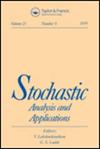Stochastic interconnected hybrid dynamic modeling for time-to-event processes
IF 0.7
4区 数学
Q3 MATHEMATICS, APPLIED
引用次数: 0
Abstract
Abstract In this work, an attempt is made to develop an innovative alternative stochastic interconnected hybrid dynamic model for time-to-event processes in a systematic and unified way. The procedure is composed of the following components: (1) development of a continuous-time state dynamic model, (2) formulation of an interconnected hybrid dynamic model composed of both continuous and discrete-time states of time-to-event processes, (3) derivation of conceptual computational interconnected dynamic algorithm for time-to-event data statistic, and (4) construction of conceptual and computational simulation dynamic procedure for state and parameter estimations. The development of the presented approach is motivated by parameter and state estimation of time-to-event processes in biological, chemical, engineering, epidemiological, medical, military, and social dynamic processes under the influence of discrete-time intervention processes. The presented algorithm is independent of any particular form of survival distributions or data sets. Moreover, it does not require a closed form survival function distributions. The introduction of intervention processes provides a measure of influence of new tools/procedures/approaches in continuous-time states of time-to-event dynamic process. In particular, it generates a measure of the degree of sustainability, survivability, reliability of a time-to-event process. In addition, intervention processes provide comparison between the past and currently used tools/procedures/approaches/etc. The developed procedure coupled with modified Local Lagged Adapted Generalized Method of Moments (LLGMM) approach also provides a measure of degree of confidence, prediction, and planning assessments.时间-事件过程的随机互联混合动态建模
本文章由计算机程序翻译,如有差异,请以英文原文为准。
求助全文
约1分钟内获得全文
求助全文
来源期刊

Stochastic Analysis and Applications
数学-统计学与概率论
CiteScore
2.70
自引率
7.70%
发文量
32
审稿时长
6-12 weeks
期刊介绍:
Stochastic Analysis and Applications presents the latest innovations in the field of stochastic theory and its practical applications, as well as the full range of related approaches to analyzing systems under random excitation. In addition, it is the only publication that offers the broad, detailed coverage necessary for the interfield and intrafield fertilization of new concepts and ideas, providing the scientific community with a unique and highly useful service.
 求助内容:
求助内容: 应助结果提醒方式:
应助结果提醒方式:


